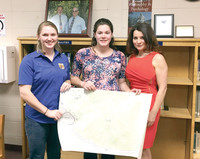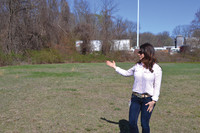By TIM FORSBERG The sky is the limit for students at Sarah Dyer Barnes Elementary School thanks to a recently approved outdoor classroom program. During last week's Johnston School Committee meeting, the body unanimously approved a collaborative
This item is available in full to subscribers.
We have recently launched a new and improved website. To continue reading, you will need to either log into your subscriber account, or purchase a new subscription.
If you are a current print subscriber, you can set up a free website account by clicking here.
Otherwise, click here to view your options for subscribing.
Please log in to continue |
|


The sky is the limit for students at Sarah Dyer Barnes Elementary School thanks to a recently approved outdoor classroom program.
During last week’s Johnston School Committee meeting, the body unanimously approved a collaborative program between the school, the U.S. Fish and Wildlife Service (USFWS) and the Audubon Society to construct an outdoor classroom with corresponding curriculum at Barnes.
“Last year, we had a small group of students along with some parents and Mrs. Jennifer Morrell design an outdoor classroom, never thinking that we would place second,” said Principal Jill Souza. “This year we were very lucky because the Audubon Society and Cindy Corsair (of the USFWS) reached out to us to actually create that classroom, an exact replica of it or enhance it and design it the way that we see fit at Barnes.”
Cindy Corsair is a fish and wildlife biologist with the USFWS. She works for the ecological services within the department assisting landowners to create wildlife habitats and to protect important areas for priority wildlife species. Corsair is also a graduate of Barnes Elementary School.
During the past several years, Corsair and her colleagues have focused on connecting the public with nature and promoting environmental awareness. Part of that mission is bringing access to nature to people that may not be able to get to the green spaces and refuges that they manage. They created an urban initiative that includes the Schoolyard Habitat Program.
“That’s where we come in to restore wildlife habitat on school grounds and allow for that connection to happen and also enhance the curriculum objectives that may give another tool to reach those objectives,” said Corsair.
According to Corsair’s presentation, there’s “a ton” of information and research on the benefits of getting children outdoors, including heightened focus, improving test scores and creating a sense of stewardship. She and her department will provide support and technical assistance during the three-year project.
Highlights of the program include an ecologically sound classroom instruction plan that benefits people and wildlife, an integrated and adapted curriculum for students, and a plan that is part of a nationally recognized program with more than 500 schools participating.
“We have a great pool of teachers who have come together, and we’ve been meeting on a monthly basis along with parents to create the plan. We’ve assessed where on the school grounds it would be appropriate to place the outdoor classroom,” said Jennifer Morrell, a teacher at the school who has helped spearhead the project. “This is the first phase of a three-phase project, but the outdoor classroom itself is the first phase so that’s what we’ve been working on this year, finding a place that would feel like a classroom to the students and not feel like recess.”
They are hoping to complete phase one by the end of this school year. It includes creating a trail leading to the classroom in the field behind Barnes. They’ve discussed lining the trail with bricks decorated by students in art class. The classroom space would have log seating, with students planting a flower/pollinating garden to attract local insects, in which trials may be run utilizing different plants.
In the fall, the project’s partners from the Audubon will provide special development plans to the teachers through two workshops that will provide example lesson plans and help them to get comfortable teaching in the outdoors and feel confident in the course content. The Audubon is creating a lesson plan specific to Rhode Island.
The goal of the school through the program is to enhance their science curriculum, help students spend more time outdoors, enhance creativity and assist students by having them learn through engagement.
Corsair explained that projects like these typically cost between two to three thousand dollars, and the grant provided to the school by the USFWS for the program is three thousand dollars spread out over three years. When phase one is complete, a ribbon cutting ceremony will celebrate the opening of the classroom.
“I haven’t strayed very far, I’m really excited to bring this program to my hometown and my school that I grew up in,” said Corsair. “It’s been a blast from the past to come back and walk the halls now, but it’s really nice to work in my home community.”
Principal Souza said she has a “great team” working on this project, including teachers, parents, and the school community.
“We’re very lucky that the students’ dream of building that outdoor classroom is now becoming a reality,” she said.
Comments
No comments on this item Please log in to comment by clicking here